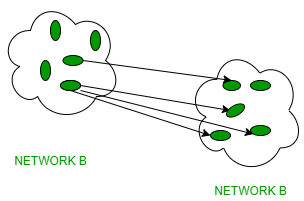1.广播:
广播传输(一对一)技术,可以分为两种类型:受限广播,直接广播。在广播模式下,传输从一台主机传输到LAN上连接的所有其他主机。桥等设备使用此功能。诸如ARP之类的协议实现了这一点,以便知道主机对应IP地址的MAC地址。 ARP确实将ip地址转换为mac地址。 RARP则相反。

2.组播:
多播有一个/多个发送者,一个/多个接收者参与了数据传输流量。在多播中,流量斜倚在单播和广播的边界之间。它是服务器的直接数据流单副本,然后将其模拟并路由到请求它的主机。 IP多播需要支持其他一些协议,例如IGMP(Internet组管理协议),多播路由才能正常工作。而且在有类IP寻址中,类D保留用于多播组。

广播和组播之间的区别:
| S.No. | Broadcast | Multicast |
|---|---|---|
| 1. | It has one sender and multiple receivers. | It has one or more senders and multiple receivers. |
| 2. | It sent data from one device to all the other devices in a network. | It sent data from one device to multiple devices. |
| 3. | It works on star and bus topology. | It works on star, mesh, tree and hybrid topology. |
| 4. | It scale well across large networks. | It does not scale well across large networks. |
| 5. | Its bandwidth is wasted. | It utilizes bandwidth efficiently. |
| 6. | It has one-to-all mapping. | It has one-to-many mapping. |
| 7. | Hub is an example of a broadcast device. | Switch is an example of a multicast device. |